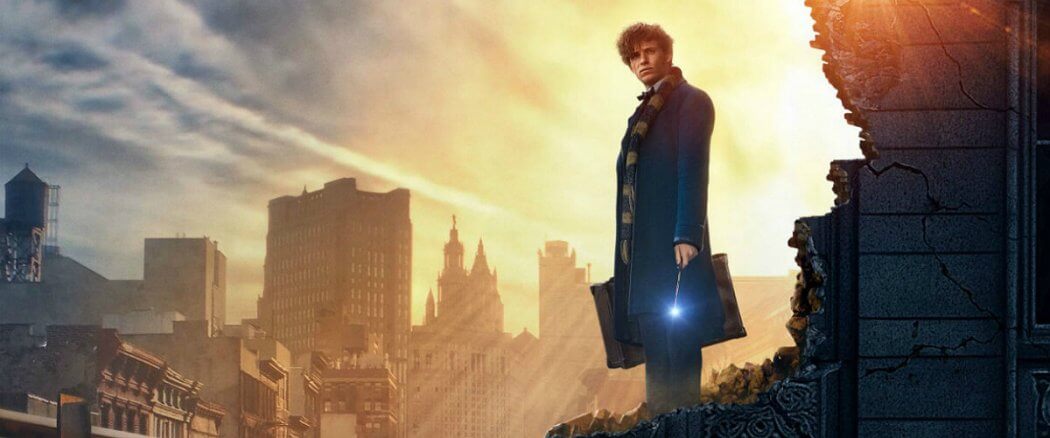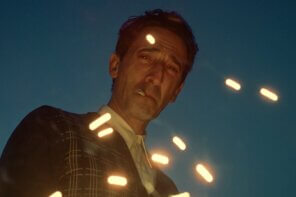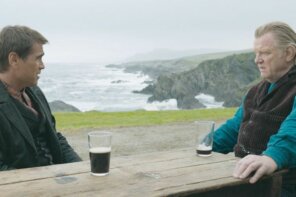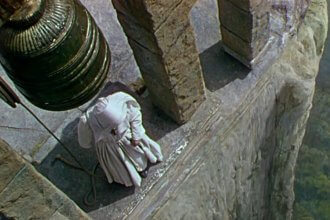While it can’t be denied that fatigue exists in this new world of movie universes — Marvel, DC, Middle Earth, Star Wars, Star Trek, etc. — there’s also something to be said for familiarity. For every let down like The Hobbit, there’s a welcome return like The Force Awakens. And that makes sense: People like to feel comfortable.
However, that doesn’t seem to be the aim of J.K. Rowling’s new venture into the Wizarding World, Fantastic Beasts and Where to Find Them. Throughout the Harry Potter franchise, fans got used to seeing the impossible — dare I say, the magical? — become reality on their screens. Students on brooms became as normal as drivers in cars, and you were more likely to see a man transform into a dog than walk one on a leash. By the end of The Deathly Hallows Pt. 2, every spell and magical whimsy from Rowling’s mind had become mere child’s play for special effects artists.
In this new setting in Rowling’s world, viewers will find no such thing. Following the visual style of David Yates — the director of the final four Harry Potter films — Fantastic Beasts is a drab, moody visual affair, set amongst the grayscale buildings and skies of New York. The visual cues are a subtle reminder to the audience: this isn’t Hogwarts, where dreams are realized. This is the real world, a world where people can be cold and cruel to those different than them.
Beasts vs. Creatures
There’s no denying Fantastic Beasts and Where to Find Them is J.K. Rowling’s most political work yet. Yes, the Harry Potter films were fixated on the idea of inclusiveness vs. bigotry, compassion vs. fear. But if those tensions are ripe for conflict in 1990’s England, they’re deep-seeded and normalized in 1920’s America. Humans call for a “new Salem” to rid the city of witches. Witches and wizards banish the possession of magical creatures, afraid of how they might expose the magical realm. And worst of all, magical folk treat No-Maj’s — the American term for the non-magical population — with a sickening sense of superiority, as if they too were beasts to be avoided. It’s a curious dichotomy: while Gellert Grindlewald stokes the flames of No-Maj extinction, MACUSA — Magical Congress of the USA — treats them with a cloying indifference. They’re two points on the same arrow, both pointing to the extremism displayed by Voldemort in the original series.
 Luckily, we have Eddie Redmayne’s Newt Scamander, a quiet, stuttering man known for his love of “creatures.” It’s important, I think, to note that Scamander calls them his creatures and not “beasts” as many in the wizarding world do. It’s subtle commentary, reminding the viewer of a theme spoken by Sirius Black in the original films, “If you want to know what a man’s like, take a good look at how he treats his inferiors, not his equals.”
Luckily, we have Eddie Redmayne’s Newt Scamander, a quiet, stuttering man known for his love of “creatures.” It’s important, I think, to note that Scamander calls them his creatures and not “beasts” as many in the wizarding world do. It’s subtle commentary, reminding the viewer of a theme spoken by Sirius Black in the original films, “If you want to know what a man’s like, take a good look at how he treats his inferiors, not his equals.”
Regardless of what you think of her ideas, there’s little doubt as to where Rowling stands on this America. From the outset, it’s a place suspicious of outsiders, a sentiment that gets more sinister and noticeable as we travel further into its interior.
Bowtruckles, Nifflers, and the Stakes
While Fantastic Beasts may not be as obviously fantastical as its counterpart films, the highlight is still magical in nature: the creatures. Newt Scamander’s furry, scaly, and mischievous companions add a splash of beauty to a world desperately needing it. Again, the motif of multiculturalism is at play, but it’s almost second nature to the grandiose of the visual design. Each creature feels new and exciting, yet strangely familiar in the context of the magical world. Of particular interest are names Harry Potter fans will recognize like the Niffler and the Bowtruckle, two of the central creatures in the narrative.
And yet Rowling’s most poignant creation has to be the Obscurial, a vague, powerful creature born of repressed magic. No spoilers, but of all the creatures, the Obscurial paints the best picture of the cold, unwelcoming world Rowling wants to portray with this universe.
In fact, one of the films shortcomings seems to be the creatures sometimes take precedent over the characters themselves. At some points, I found myself caring more about what would happen to the Bowtruckle than any of the four heroes. Rowling does such a wonderful job as painting her creatures as valued and threatened, it’s easy to forget the other stakes.
“Magic is Might”
In all reality, Rowling isn’t really diverging from the themes she talked about in Harry Potter. One she chooses to tackle in the first Fantastic Beasts is exceptionalism, specifically as it refers to wizards and Muggles/No-Maj’s. The saying, “Magic is might,” gets tossed around toward the end of the Harry Potter series, a refrain used by dark wizards promoting the idea that non-magical people are less evolved and less precious than those with wizarding blood. It fuels the doctrine of ‘pure blood’ mania and the desire to rid the wizarding world of Mudbloods — wizards and witches with non-magical parents.
Again, these same ideas are at play in Fantastic Beasts. While these themes aren’t tackled head on quite like in the Potter series, they’re addressed in subtler ways. MACUSA is condescending of the No-Maj world, with some inside their ranks wishing to take the next step into hostility. Magical ability is seen not as a gift or ability to be stewarded, rather as an inheritance to be guarded and kept secret. As a result, the world is a much colder place. In truth, the main conflict boiling under the surface comes down to the fear of the other, magical or otherwise.
 Some actors in Fantastic Beasts play this spectrum of fear and condescension beautifully, while others don’t have much to do. Eddie Redmayne is a servicable lead, a choice that should reap benefits throughout the franchise. But given his fascination with his creatures, he almost becomes a non-factor. Similarly, Colin Farrell is fine as head auror Percival Graves, but he too becomes too one-note. It’s a shame since the two are easily the most talented actors in the bunch. Katherine Waterston’s Tina Goldstein has perhaps the most interesting arc in the film, and she plays it well. Waterston might be the understated casting of this series, a choice that will continue to pay off down the line. And perhaps the biggest delight of the film comes from side-players Alison Sudol and Dan Fogler, the former as Queenie Goldstein, the latter as Jacob Kowalski.
Some actors in Fantastic Beasts play this spectrum of fear and condescension beautifully, while others don’t have much to do. Eddie Redmayne is a servicable lead, a choice that should reap benefits throughout the franchise. But given his fascination with his creatures, he almost becomes a non-factor. Similarly, Colin Farrell is fine as head auror Percival Graves, but he too becomes too one-note. It’s a shame since the two are easily the most talented actors in the bunch. Katherine Waterston’s Tina Goldstein has perhaps the most interesting arc in the film, and she plays it well. Waterston might be the understated casting of this series, a choice that will continue to pay off down the line. And perhaps the biggest delight of the film comes from side-players Alison Sudol and Dan Fogler, the former as Queenie Goldstein, the latter as Jacob Kowalski.
Kowalski — a No-Maj forced into Scamander’s hunt for the creatures — is a delight and easily the most relatable character of the story. His childlike wonder at being introduced to magic is not unlike a first experience with a Harry Potter book. Yet he still rises to the occasion, a hero trapped in a world that, for the most part, doesn’t want him. His story takes a turn toward the unknown at the end, and I hope he’s brought back for more movies.
Similarly, Sudol represents every good thing fans love about the universe. She’s a wholly realized side character with a genuine narrative backbone, of the Neville Longbottom and Luna Lovegood ilk. Sudol brings a sweetness to Queenie that the film desperately lacks, one that could be vital as the series gets longer and probably darker. Again, here’s to hoping she’ll be back.
Four More Movies?
So what are we to make of this return to the wizarding world? Large swaths of Harry Potter fans are satisfied, but many critics have grieved the fact there are still four movies to go. And yes, the task of watching a movie with four more in mind is daunting.
But it would also be premature to cast off hope the Fantastic Beasts series, especially when it’s in the hands of creative minds experienced in long-form storytelling. And that’s not even considering the first entry is a form unto itself. Remnants of the Harry Potter universe exist, and while they’re not quite as fantastic as many would have hoped, they point to a story that looks to address a wide range of topical themes. It’ll be fascinating to see where Rowling goes from here, and if this first film is any indication, she’ll continue making good on all the trust she’s earned over the years.





